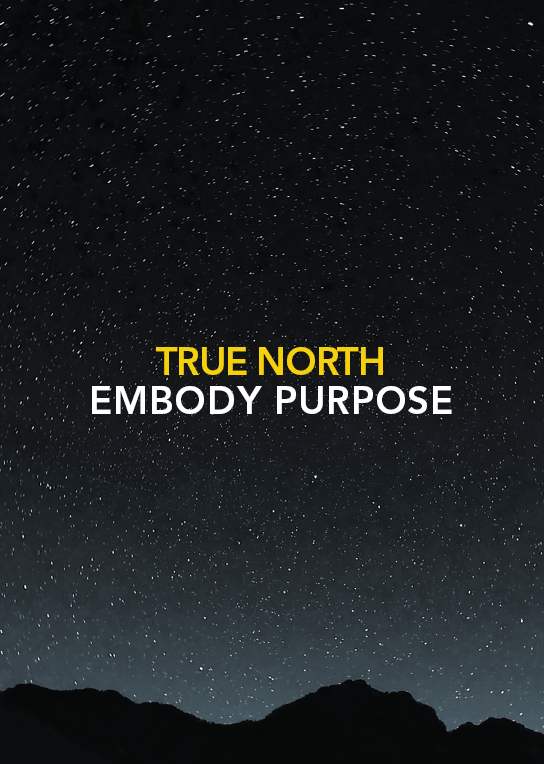A bright point in the night sky—the star, Polaris, the astronomical “True North”—has guided explorers, adventurers, and travelers from time immemorial. Even today, before charting any course, travelers must orient first to their own True North to find their bearings.
Your leadership journey, too, starts with the True North of Embodying Purpose, the “why” of the journey. With a clear and compelling purpose, you set the strategy and gather the people who will join you on the journey. Here you will ponder the basic questions: Why are you making the trip, how will you travel, and who will go with you? As a leader of others (in our example, thousands of others), you cannot expect people to follow blindly. You will need to show them the True North of Embodying Purpose so they, too, can embrace the “why” of the journey.
For the 4,000 people walking from New York to Los Angeles, there could be any number of “whys”—to build a team, to challenge themselves, to support a cause, to make a difference.
Just like the few who have scaled Mount Everest, these intrepid long-distance walkers may be motivated by the desire to accomplish what only a few have ever done. Where there is purpose, there is hope of succeeding—and exceeding what anyone thought possible.
On every leadership journey, the specific “why” will be unique to each organization and its desired destination. What is universal to all is the importance that everyone understands that specific “why.” The more people embrace the purpose, the more likely they will follow—not only at the beginning when adrenaline is pumping and excitement is running high, like at the start of a marathon, but later on when the going gets tough, and people question whether they can go another step.
As their guide and co-voyager, you must reflect on what matters most. With this knowledge, you will be better able as the leader to align the group to the overarching purpose and passion, so that they can carry out the strategy all the way to the final destination.
Start with the “Why”—The Purpose of the Journey
Purpose Precedes the First Step.
Leaders and followers alike must understand the “why”—the purpose of the journey—before they can take the first step along a path that will take them many years and thousands of miles (literally or figuratively).
Over the years, I've seen leaders jump ahead to the “how” and forget the “why”—in other words, the organization's purpose. Obviously, every leader must set the destination or the vision (the “what”) as well as the strategy (the “how”). Similarly, every organization must make money, and every team must win; these are table stakes. The real question, however, is always: “Why?” Why is the organization in business? Knowing that “why” drives and sustains employees' motivation.
Why the “Why” is So Important.
Most people want to grow, learn, win, and be part of something bigger than themselves. They yearn to contribute to the journey, knowing that what they do and who they are matters. In short, they want to be loved.
On the leader's journey toward the envisioned destination, everyone wants to see themselves as an integral part—that's why the “why” is so important! When the leader is clear about the “why,” real transformation happens, because now everyone can not only see the vision, but picture themselves as part of it. They know what it means to “win” and feel supported in achieving that goal for themselves and the team. Therefore, to foster alignment across an organization, the leader must define and communicate the “why”—the purpose—to every member of the team.

Knowing the “Why” Creates the Shift from “Me” to “We.”
The reality is that thousands of employees could be making hundreds of decisions every day. You will not be looking over their shoulders, nor could you. Rather, your job is to paint the left and right lines, set the destination, alter course if needed, and, most importantly, anchor the organization in purpose. Giving people a sense of “why” they are doing what they do transforms self-interest to shared interest.
When your employees have a strong sense of purpose, they are more likely to act in concert with the mission and objectives of the organization. People will row in the same direction, to the same finish line. As a leader, your responsibility is to cast purpose as the long shadow over the organization.
Purpose is the Key to Culture Fit.
Over the past several years, our firm has completed several acquisitions—all strategic in terms of expanding our reputation as the leading global people and organizational advisory firm. What makes an acquisition successful, though, is not the numbers on paper, no matter how good they may look. It's all about the culture—in particular, blending the cultures of two organizations into one. The best way to do that is with alignment around a common purpose, bringing people together to pursue the greater “why.” Without that alignment, culture clashes will likely happen, which can derail even the most strategic-looking merger.

When our firm makes an acquisition, I personally make numerous phone calls to as many as 100 people in the acquired firm to talk about our purpose—our “why”—which is all about changing people's lives. (I also have continuous conversations within the firm around the strategic advantage of a particular acquisition, which is always discussed in terms of our purpose.) These open, candid communications help keep our culture grounded in the greater purpose, which is essential at all times and even more so during an acquisition.
When one company acquires another, the result may be a “Noah's Ark”: two of everything, and sometimes in key positions. Aware of the overlap and redundancy, people become nervous. Ambiguity about what will happen to their jobs can quickly lead to mistrust and trigger the departure of key people. The same people who made the acquired firm attractive in the first place could very well be the first ones heading to the exit! However, when people understand and embrace purpose, they can see themselves more comfortably as part of a new, expanded team. The more they grasp and embody the overarching purpose, the more they will ultimately drive the long-term success of the acquisition. That's why the acquisition is not an end point, but a beginning—starting with alignment around the “why.”
The Companion of Purpose is Vision.
If purpose is the “why,” then vision is the “what.” Vision is best thought of as the picture of “what” is to be accomplished—“what” the organization will look like when the purpose is realized. Together, purpose and vision form the basis of leadership. Although leadership styles may differ, purpose is always the driving force behind achieving the vision.
Describe the Vision with Words that Resonate.
What is your vision? Can you describe it in a way that others can see it clearly? If it's vague in your mind, it will be impossible for others to see it. That's why companies set their destinations with “vision statements” that vividly paint purpose.
In 1980, Steve Jobs's mission statement for Apple was, “To make a contribution to the world by making tools for the mind that advance humankind.” LinkedIn evokes community-building in its mission: “Connect the world's professionals to make them more productive and successful.” Outdoor clothing and gear company Patagonia offers an all-encompassing statement that succinctly describes a vision of doing good in the world: “Build the best product, cause no unnecessary harm, use business to inspire and implement solutions to the environment crisis.” IKEA's vision is as straightforward and functional as its line of home goods and furnishings: “…to create a better everyday life for many people.”
What makes a mission and vision statement meaningful is not the eloquence of the words, but their sincerity and authenticity, as embodied by the leader and modeled for every person on the team.
As we discussed purpose, Ken Blanchard, author of the Afterword, recounted this story from his days of teaching at the University of San Diego School of Business Administration, where he always gave out copies of the final exam on the first day of class so that students would know exactly what they were expected to learn. The rest of the course was devoted to helping students master the concepts and material. Ken's university colleagues, however, were up in arms. Why would he do such a thing as giving students the final exam from the beginning of the class? Ken explained his purpose—his “mission statement” of what he intended the outcome to be: “I don't want them to fail,” Ken said. “I want them to learn.”
Leaders Raise the “Altitude” of the Organization.
As a leader, you must embody purpose. It is no less than the basis of everything you do. People need to look in your eyes and sense the unalterable truth of that purpose—what it stands for and where it will take them. The “why” of the journey becomes omnipresent—on the walls and in the halls.
When people embrace a greater purpose in all that they do, it creates change and inspires possibility. It is the organizational beacon illuminating the horizon—the long-term vision. Purpose is the constant through the agony of failure and the euphoria of success. To understand “why” is to claim an enduring purpose.
Strategy—Defining the “How”
Set the Starting Point.
If the “why” is the purpose and the “what” is the vision, then strategy is the “how.”
Strategy is one of those words—used everywhere, to the point of losing its punch. Senior executives are praised for being “real strategic thinkers” or “very strategic.” Of course they should be; that's a given! However, strategy is more than just the road to travel. It also encompasses how you are going to travel, when you will launch, where you are going, and the time needed to reach the destination.
Remember the “Caterpillar Effect.”
Strategy begins with an assessment of today's reality, not tomorrow's promise. Most people are familiar with the “butterfly effect,” which states that seemingly small or even insignificant causes (a butterfly flapping its wings) can have enormous impacts (stirring the wind until there is a tornado). I like to think of strategy in terms of the “caterpillar effect,” which inherently contains the most important elements of strategy: reality and pacing. The “caterpillar effect” reminds us that a caterpillar cannot be a butterfly while it is still a caterpillar. Its transformation is a process, grounded in the reality of today. If the caterpillar ignores that reality and decides it can fly—pushing its capabilities prematurely—it won't get off the ground. You can't rush the process.
Caterpillars take time to turn into butterflies, just like organizations take time to launch, grow, transform, and progress into their next stage of development. As R. Buckminster Fuller said: “There is nothing in a caterpillar that tells you it's going to be a butterfly.” But just as surely as the caterpillar will become a butterfly (the transformation “strategy” is embedded in its DNA), an organization with a solid strategy grounded in reality will be able to “take off” into its next iteration. But it starts with reality and requires the right pacing of the process.

Your Starting Point: Take a “Selfie” of Today.
The starting point of strategic thinking is a “selfie” of today—both outside-in and inside-out. Outside-in considers influences of external forces, including customers, megatrends, competitors, product innovation, and so forth. Inside-out looks at the internal forces that address the external, such as leadership, people, organizational capability and alignment, infrastructure, technology, and the like. Both perspectives are needed to draw the strategic road map—setting the how, when, and where—once again, starting with today's reality.
Strategic Velocity is as Important as Strategic Direction.
Here's a leadership truth: You can't move an organization faster than its people and culture can absorb. Even the best strategy on paper isn't any good if you can't execute it on schedule. A brilliant plan that only gets halfway there is a failed plan. The finesse of leadership is shifting the culture and direction of the organization at a pace that matches your organizational capability as well as your strategy. Establish the sequencing and know the gating. Don't stop connecting (and communicating) the dots between why and how—the purpose and strategy.
Passionate Employees and Delighted Customers Drive Successful Strategy.
How do you know your strategy is working? Some organizations use revenue and earnings growth, shareholder value, and so forth. While important, these “hard numbers” are not the determinants of your success. As a leader, it's so easy to get caught up with so many different things that you lose sight of what is ultimately the most important. The catalysts and arbiters of your performance are your employees and customers.
If employees are passionate about the purpose and customers are absolutely delighted by how that purpose relates to them, then your organization's strategy is on the right track. In fact, with passionate employees and delighted customers you almost can't help but hit your outcome targets around revenue, profits, shareholder values, and so forth. But don't mistake the outcomes for what really drives them; it's all about the employees and the customers.
At Korn Ferry, we know that engaged colleagues and enthusiastic clients are the only true means to success. Employees who are motivated will tell others how much they enjoy working at the firm, a place of real purpose and impact—as evidenced by all those satisfied customers!
Satisfied clients will tell other potential customers about our services. After every client engagement we ask: “How did we do?” I feel an indescribable sense of pride when I run into executives around the globe who tell me, “Your firm really changed my life.” (I recall an executive who went through an extensive leadership development program and eventually became CEO of his company. When I saw him after his promotion, he was beaming with gratitude to the firm.) We want to know how and where we satisfied them and exceeded expectations, and if there are any areas in which we fell short.
By paying attention to the two factors that matter the most—employees and customers—a virtuous circle is created that leads to continuous improvement.
Do Sweat the Small Stuff.
“Don't sweat the small stuff,” the well-known adage advises. If you want to have passionate employees and enthusiastic customers, however, it's all about the small stuff. For a retailer, that means knowing what it's like to be a customer who browses the merchandise in the store. Online, it's all about the experience on the website. The same “mystery shopper” approach works in every business, to see your organization through the lens of your customers.
At Korn Ferry we frequently become the “undercover boss” when we do due diligence before making an acquisition—to see if that firm's attitude toward excellence in customer service matches ours. For example, several years ago when we were in the midst of acquiring a company with a well-respected line of leadership products, we called their sales department late on a Friday afternoon. Without telling the salespeople who we were, we ordered several leadership products and explained that they had to be delivered by Monday morning. We were very pleasantly surprised when, on Saturday morning, those products were delivered to a private residence.
Whether you take the undercover approach within your organization or for a company you are thinking of partnering with or acquiring, you will get feedback that can't compare with customer satisfaction surveys alone. Only by putting yourself in the shoes of the customers can you know if the organization really does sweat the small stuff.



